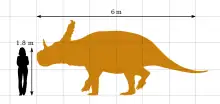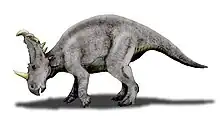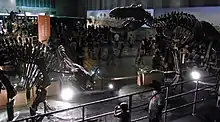| Sinoceratops Temporal range: Late Cretaceous, | |
|---|---|
 | |
| Reconstructed skeleton | |
| Scientific classification | |
| Domain: | Eukaryota |
| Kingdom: | Animalia |
| Phylum: | Chordata |
| Clade: | Dinosauria |
| Clade: | †Ornithischia |
| Suborder: | †Ceratopsia |
| Family: | †Ceratopsidae |
| Subfamily: | †Centrosaurinae |
| Genus: | †Sinoceratops Xu et al., 2010 |
| Type species | |
| †Sinoceratops zhuchengensis Xu et al., 2010 | |
Sinoceratops /ˌsaɪnoʊˈsɛrətɒps/ is an extinct genus of ceratopsian dinosaur that lived approximately 73 million years ago during the latter part of the Cretaceous Period in what is now Shandong province in China. It was named in 2010 by Xu Xing et al. for three skulls from Zhucheng, China. The name of its type species Sinoceratops zhuchengensis means "Chinese horned face from Zhucheng", after the location of its discovery.
Sinoceratops was a medium-sized, averagely-built, ground-dwelling, quadrupedal herbivore. It could grow up to an estimated 6 metres (20 ft) in length and weigh up to 2 tonnes (2.0 long tons; 2.2 short tons). It was the first ceratopsid dinosaur discovered in China, and the only ceratopsid known from Asia. All other centrosaurines, and all chasmosaurines, are known from fossils discovered in North America, except for possibly Turanoceratops. Sinoceratops is also significant because it is one of the largest known centrosaurines, and is much larger than any other known basal members of this group.
Sinoceratops was discovered in the Hongtuya Formation, which was deposited during the late Cretaceous. It lived alongside leptoceratopsids, saurolophines, and tyrannosaurines. The most common animal in the formation was Shantungosaurus, to which most of the material has been assigned. The animals living alongside Sinoceratops and Shantungosaurus were Zhuchengceratops, Zhuchengtitan, and Zhuchengtyrannus.
Discovery

The holotype specimen ZCDM V0010, consisting of a partial skull, including a braincase, was in the summer of 2008 recovered at the Hongtuya Formation of the Wangshi Group in Shandong, China.[1][2] The specimen was collected in fluvial sediments that were deposited during the Campanian-Maastrichtian stages of the Cretaceous period, approximately 72–66 million years ago.[3] Two other specimens have been recovered from the same formation. Specimen ZCDM V0011 is a partial skull that consists of the skull roof and most of the braincase, and ZCDM V0012 represents a partial braincase.[1]
The genus name Sinoceratops means "Chinese horned face", and is derived from the word Sino- referring to China from Latin Sina, the country of its discovery, and the Greek words keras (κέρας) meaning "horn", and ops (ωψ) meaning "face".[4] Sinoceratops was described and named by paleontologist Xu Xing and colleagues, in 2010. The type species is Sinoceratops zhuchengensis. The specific name refers to the location of its discovery, the city of Zhucheng which also financed the excavations.[1]
The discovery was significant, because it represented the first ceratopsid known from China, and possibly the only ceratopsid from Asia. The only other possible Asian ceratopsid is Turanoceratops, however, its position within the Ceratopsidae is contested.[1]
Description

Sinoceratops was a large ceratopsian, with an estimated length of 6 metres (20 ft) and body mass of 2 tonnes (2.0 long tons; 2.2 short tons).[5] It has a short, hooked horn on its nose (called a nasal horn), no horns above its eyes (brow horns), and a short neck frill with a series of forward-curving hornlets that gave the frill a crown-like appearance. Inside this row of hornlets there is a series of low knobs on the top of the frill, which are not seen in any other horned dinosaur. Sinoceratops is a member of the short-frilled ceratopsids, the Centrosaurinae. Holotype specimen ZCDM V0010 consists of a partial skull with most elements of the skull roof and partial braincase. The skull of Sinoceratops is estimated to be 180 cm (5.9 ft) long making it one of the largest known centrosaurine skulls.[1]

Features that differentiate an animal from most or all others are called a diagnosis. Some, but not all, of the features in a diagnosis are also autapomorphies. An autapomorphy is a distinctive anatomical feature that is unique to a given organism.[6] According to Xu et al. (2010), Sinoceratops can be distinguished based on the following diagnostic characteristics: there are at least ten robust, strongly curved hornlike processes along the rear margin of the combined parietals, while at the same time at least four hornlike processes on the combined squamosals are present; there is a large accessory fenestra in front of the antorbital fenestra (differing from all other known centrosaurines); the external margin of the parietals is only weakly undulating (differing from all other known centrosaurines); and the presence of broad-based epoccipitals (differing from all other known centrosaurines).[1]
Classification

Sinoceratops was assigned to the taxon Centrosaurinae, as a basal member by Xu et al. (2010) based on characteristics present in the skull.[1] Sinoceratops bears several characteristics that resemble features in chasmosaurines, blurring the distinction between the Centrosaurinae and Chasmosaurinae. According to Xu e.a. the basal position of Sinoceratops indicates that ceratopsids originated in Asia.[1] Sinoceratops however, shares a number of features with advanced centrosaurines such as Centrosaurus and Styracosaurus that are not seen in primitive centrosaurines like Diabloceratops, including a well-developed nose horn and reduced brow horns. The implication might be that this genus represents a lineage that invaded Asia from North America through Beringia.[7]
The cladogram below represents a phylogenetic analysis by Chiba et al. (2017):[8]
| Centrosaurinae |
| |||||||||||||||||||||||||||||||||||||||||||||||||||||||||||||||||||||||||||||||||||||||||||||||||||||||||||||||
Paleoecology

Sinoceratops is known from the Hongtuya Formation of southern China. It is known from skull material. Alongside it, in the formation, lived Shantungosaurus, a very common hadrosaurid to which most of the material has been assigned,[1][9] Zhuchengtyrannus, an Asian tyrannosaurid related to Tarbosaurus,[1] Zhuchengceratops, an Asian leptoceratopsid,[10] and Huaxiaosaurus,[11] a possible older individual of Shantungosaurus.[3][11]
See also
References
- 1 2 3 4 5 6 7 8 9 10 Xu, X., Wang, K., Zhao, X. & Li, D. (2010). "First ceratopsid dinosaur from China and its biogeographical implications". Chinese Science Bulletin. 55 (16): 1631–1635. Bibcode:2010ChSBu..55.1631X. doi:10.1007/s11434-009-3614-5. S2CID 128972108.
{{cite journal}}: CS1 maint: multiple names: authors list (link) - ↑ "PBDB". paleobiodb.org. Retrieved 2022-12-13.
- 1 2 Holtz, T.R. Jr. (2012). Dinosaurs: The Most Complete, Up-to-Date Encyclopedia for Dinosaur Lovers of All Ages. Indiana University Press. p. 47. ISBN 978-0-375-82419-7.
- ↑ Liddell, Henry George and Robert Scott (1980). A Greek-English Lexicon (Abridged ed.). United Kingdom: Oxford University Press. ISBN 978-0-19-910207-5.
- ↑ Paul, Gregory S. (2016). The Princeton Field Guide to Dinosaurs. Princeton University Press. p. 286. ISBN 978-1-78684-190-2. OCLC 985402380.
- ↑ Futuyma, D.J. (2013). Evolutionary Biology (Third ed.). Sunderland: Sinauer Associates Inc. p. 95. ISBN 978-1-60535-115-5.
- ↑ Glut, D.F. (2012). Dinosaurs, the Encyclopedia, Supplement 7. McFarland & Company, Inc. p. 866. ISBN 978-0-7864-4859-3.
- ↑ Kentaro Chiba; Michael J. Ryan; Federico Fanti; Mark A. Loewen; David C. Evans (2018). "New material and systematic re-evaluation of Medusaceratops lokii (Dinosauria, Ceratopsidae) from the Judith River Formation (Campanian, Montana)". Journal of Paleontology. 92 (2): 272–288. doi:10.1017/jpa.2017.62. S2CID 134031275.
- ↑ Hu, C.C. (1973). "[A new hadrosaur from the Cretaceous of Chucheng, Shantung]". Acta Geologica Sinica. 2: 179–206.
- ↑ Zhao, X.; Li, D.; Han, G.; Zhao, H.; Liu, F.; Li, L. & Fang, X. (2007). "Zuchengosaurus maximus from Shandong Province". Acta Geoscientia Sinica. 28 (2): 111–122. doi:10.1007/s10114-005-0808-x. S2CID 119700784.
- 1 2 Zhao X.; Wang K. & Li D. (2011). "Huaxiaosaurus aigahtens". Geological Bulletin of China. 30 (11): 1671–1688.
External links
 Media related to Sinoceratops at Wikimedia Commons
Media related to Sinoceratops at Wikimedia Commons- "Sinoceratop zhuchengensis". Paleobiology Database: Classic.

.png.webp)


